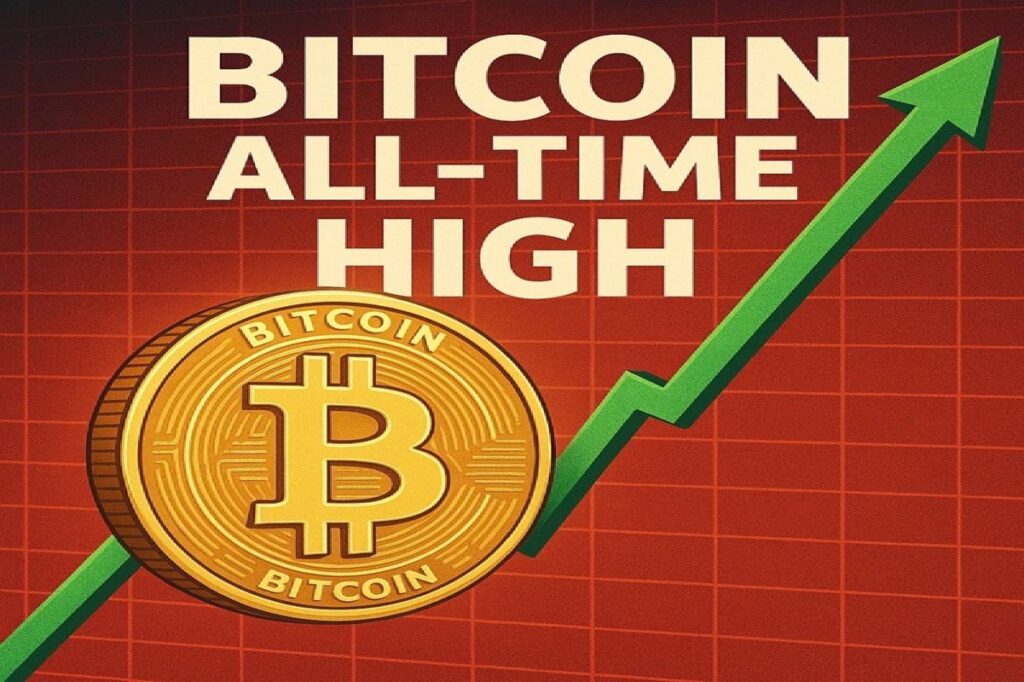Author: Akshay Published Date: 12 July 2025
The King Is Back: Bitcoin Breaks Through $113K
Early in July 2025, Bitcoin (BTC) reached the $113,000 barrier, marking a momentous event that rocked the world’s financial markets and continued a strong run that has drawn interest from both institutional and ordinary investors.
Bitcoin was recovering from its post-2021 bad cycle and was trading in the $30,000–40,000 range just two years ago. Fueled by a confluence of macroeconomic tailwinds, corporate interest, and rekindled optimism in the digital asset market, it now stands gloriously at $117,848, as of right now.
However, what is driving this rally? Let’s investigate further.
A Rally Based on FOMO and Fundamentals
This time, Bitcoin’s price momentum is supported by strong fundamentals rather than just excitement. In contrast to previous bull runs, institutional inflows, historic crypto rules, and real demand from conventional financial markets are all contributing to the 2025 spike.
Bitcoin has actually outperformed the majority of stock indices and other asset classes, having increased by more than 26% so far this year.
A modest springtime climb has turned into a mid-year meteoric ascent. The surge past $113,000 wasn’t a sudden burst of excitement; rather, it was the result of weeks of methodical, consistent accumulation by important participants.
Institutional Capital Is Present and Won’t Go Away
The sheer magnitude of institutional adoption in 2025 is among the most notable distinctions from previous rallies.
Nearly 850,000 BTC are currently stored on company balance sheets, up 23% from 2024, according to digital asset management firm Bitwise. Alongside trailblazers like MicroStrategy, corporates from tech companies like Figma to retail disruptors like GameStop have begun embracing Bitcoin as a treasury reserve asset. This isn’t about following trends. It has to do with capital growth, inflation hedging, and diversification. These businesses view Bitcoin as a real, long-term asset rather than merely a risky play.
“Corporates are no longer dipping their toes—they’re diving in,” said Gerry O’Shea from Hashdex, a leading crypto ETF provider.
The tide has turned thanks to ETFs. The spike in spot Bitcoin ETF flows may have been the primary driver of Bitcoin’s latest breakout. Bitcoin ETFs saw inflows of over $1.1 billion in a single day just last week, pushing the year-to-date total to over $50 billion. In contrast, that amount more than triples the inflows of gold ETFs within the same time frame.
What does this signify?
This implies that conventional investors, such as hedge funds, family offices, and pension funds, can now access Bitcoin exposure without the need for wallets, keys, or cryptocurrency exchanges. similar to purchasing stock. They’re also purchasing it. In historical quantities.
US Crypto Law Finally Gets Its Footing. If regulatory uncertainty hindered the 2021 bull run, then the sudden legislative clarity in 2025 is helping.
The long-awaited GENIUS Act, a legislative framework that establishes safeguards for crypto custody, legitimizes stablecoins, and specifies tax structures for gains on digital assets, was passed by Congress in June. The fact that crypto has become a bipartisan topic is even more noteworthy. Both of the major US parties are now trying to come off as crypto-friendly in anticipation of the 2026 elections. In order to establish Bitcoin as a possible strategic financial asset for the US, former President Donald Trump has already stated his support for a Strategic Bitcoin Reserve.
“We must lead the future, not follow it,” he said at a recent rally, directly referencing Bitcoin’s role in innovation and national security.
Capital Is Investing in Crypto Due to a Wider Risk-On Attitude. Zooming out, the rally in Bitcoin is part of a larger story: world markets are once again optimistic. Global central banks are warily exploring rate cuts, the Nasdaq is at all-time highs, and inflation seems to be slowing. As usual, Bitcoin is among the first to benefit from this renewed interest in riskier assets. Additionally, Bitcoin is becoming more and more seen as digital gold. When market sentiment is positive, money tends to go into store-of-value assets with significant upside potential.
Watch Out for the Short Squeeze.
Another unspoken element influencing this rally? An enormous short squeeze. As Bitcoin broke through important resistance zones, short positions totaling more than $1 billion were liquidated in the last 72 hours. This increased the rising trend of the stock by forcing bears to repurchase their positions. Every increase leads to more liquidation, which in turn leads to more buying, which drives prices even higher. This is a classic example of compounding the fire.
Is This Only the Start?
Analysts believe that the current rally might still be in its early phases. By Q4 2025, Hashdex predicts that Bitcoin will reach $140,000.
Matthew Sigel of VanEck thinks that if legislative certainty persists and ETF demand holds, Bitcoin may reach $180,000. Google searches for “how to buy Bitcoin” have increased by 60% month over month, indicating that retail investors are also making a comeback to the market. Ethereum and other altcoins, such as Solana and Chainlink, are also exhibiting strength, suggesting that this could be a crypto market renaissance rather than just a Bitcoin rally.
From Here, Where Do We Go?
Even while the fundamentals of Bitcoin are stronger than ever, experienced investors will keep in mind that volatility is a part of the game.
There will be corrections. Regulations may falter. Whales may suck. However, the institutional framework established in 2025 is significantly more robust than anything we have ever seen.
Analysts suggest that if Bitcoin can maintain this price above the $110,000–$115000 level, the next step up might be quick and steep.
